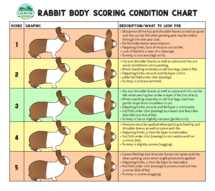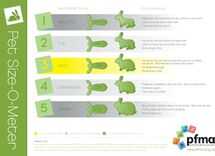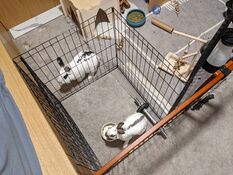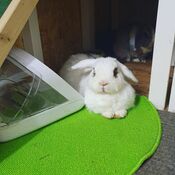Weight management
Just like humans, weight management for rabbits is important to promote health, vigor, and an extended life span.
Body condition scoring
In trials conducted at the University of Edinburgh, the rib area proved to be the most useful for assessing body fat, with the hips and spine only showing appreciable changes at extremes of body weight. The ribs are felt just behind the elbow, and the greater the pressure required, the more fat is present.[1]:62
| Score 1 Emaciated |
Score 2 Lean |
Score 3 Ideal |
Score 4 Fat |
Score 5 Obese |
|---|---|---|---|---|
|
|
|
|
|
There are many different charts and infographs that try to give a general overview of a rabbit's weight range. Some give good general information, but none take into the account that, depending on the rabbit's breed, rabbits can have different body types. It is best to consult your rabbit-savvy veterinarian if you have any concerns about your rabbit's weight.
List of the body types from ARBA:[2]
- Full arched: Belgian Hare, Britannia Petite, Checkered Giant, English Spot, Rhinelander, and Tan.
- Semi arch: American, Beveren, English Lop, Flemish Giant, and Giant Chinchilla.
- Compact: American Fuzzy Lop, English Angora, Standard Chinchilla, Dutch, Dwarf Hotot, Florida White, Havana, Holland Lop, Jersey Wooly, Lilac, Lionhead, Mini Lop, Mini Rex, Mini Satin, Netherland Dwarf, Polish, Silver, and Thrianta.
- Commercial: French Angora, Giant Angora, Satin Angora, Blanc de Hotot, Champagne d’Argent, Californian, Cinnamon, American Chinchilla, Creme d’Argent, French Lop, Harlequin, New Zealand, Palomino, Rex, American Sable, Satin, Silver Fox, and Silver Marten.
- Cylindrical: Himalayan
Here are links with information on how to score the body condition of your rabbit.
- Rabbit Welfare Association & Fund, Why do I need to body condition score my rabbit?
Overweight rabbits
Obesity is an extremely common and often debilitating problem in pet rabbits. It can pose an increased risk for other diseases such as cardiovascular, orthopedic, and liver disease as well as dermatitis and flystrike.
Fat rabbits have high resting heart rates and can develop hypertension and cardiac hypertrophy. They are unable to groom inaccessible parts such as the nape of the neck and the base of the tail or reach to consume cecals. Arthritic conditions are exacerbated by obesity. Sludgy urine and cystitis are also associated with inactive overweight rabbits.[1]:54
Causes
- Inadequate exercise — Many rabbits are kept in small cages for long periods of time with limited access to exercise areas. Most cages sold are often inadequate in size as well.
- Dietary factors — Most commercial pelleted diets are very nutrient dense. Free-choice or overfeeding of pellets is one of the primary causes of obesity in rabbits.[3] Owners may also overfeed treats.
- Habitual factors — Some rabbits refuse to eat hay or other foods in coarse, indigestible fiber. Increasing age may also contribute.
Caged, inactive, middle-aged rabbits of either gender are at increased risk. Dwarf and lop breeds may also be predisposed to obesity.[3]
Symptoms
- Excess amounts of body fat for body size.
- Ribs are not palpable and have an overlying layer of fat. Rolls of fat extend over rear limbs or hindquarters.
- Lethargy, weakness.
- Feces or cecotrophs pasted to bottom region due to inability to groom or consume cecotrophs.
- Flaky dermatitis in shoulder area due to inability to groom.
- Moist dermatitis of dewlap (especially in female rabbits).
Treatment
Weight reduction can only be achieved in rabbits by providing a diet low in digestible fiber and high in indigestible fiber. A high fiber, low calorie diet that would result in weight loss in humans and other animals may not have any effect in rabbits. The cecal micro-organisms can digest fiber to release volatile fatty acids that can be converted into fat.[1]:54
- Keep the rabbit's bottom clean, dry, and free of fecal matter.
- Remove matted hair through clipping or trimming.
- Treat dermatitis.
- Provide soft, clean flooring to help prevent sore hocks.
- Increase activity by providing access to exercise areas. Feed their pellets in puzzle toys and forage mats to encourage more activity.
- Reduce volume of pelleted foods. A maximum of 1/4 cup pellets per 5 lbs body weight is recommended. Also consider switching to a high-fiber pellet such as Oxbow. Do not feed pellet mixes containing seeds and/or dried fruit.
- Offer a large selection of fresh, moistened greens.
- Feed high-quality timothy or grass hay.
- Limit fresh fruits and non-leafy vegetable treats to 2 to 3 tsp per 5 lbs of body weight daily.
- Strictly prohibit simple sugars (yogurt drops, candies, cookies), high starch foods (bread products, grains, nuts, cereals, oats, peas), and legumes until rabbit is back to optimal weight.
Experiences
The following are stories of obese rabbits that had many serious health complications that made it much more difficult for appropriate treatment.
- Rabbit Rescue in Torun. (2019). Pumba's story
- Rabbit Rescue in Torun. (2018). Gardenia's story with flystrike (Graphic)
- Rabbit Rescue in Torun. (2018). Howie's story
- Rabbit Rescue in Torun. (2015). Czesio's story
Additional resources
The following links contain more information about caring for overweight rabbits.
- Dr. Jackie Schulman, DVM, Obese Rabbits At Risk
- Rabbit Welfare Association & Fund, Is your rabbit too fat?
- House Rabbit Network, Astrid M. Kruse, DVM, Weight Watching for Rabbits
- Flickr, Bunny Lovers Unite, Jojo's Guide to Weight / weight loss and how to diet
- Christine Carter, The Fat Rabbit
- House Rabbit Society, Sandi Ackerman, The Perils of Bunny Obesity
- PetEducation.com, Obesity-Related Health Problems in Rabbits
Underweight rabbits
A couple ways to help rabbits gain weight are the following:
- Increase portion of daily pellets or free-feed if necessary.
- Supplement a higher protein pellet. e.g. at least 16% protein or alfalfa pellets.
- Feed some alfalfa or other legume hay in addition to regular grass hay.
- Feed a little bit of grain and seeds every couple of days. These foods are high in carbs and fats. See Treats for more details.
- Add some plant-based protein powder in a pellet or recovery food mash. Soy and pea protein powder are popular choices.
- Add some Calf Manna as a supplement to your rabbit's food.
- Talk to your vet whether a motility drug such as cisapride or metoclopramide would be appropriate to increase a rabbit's appetite.
If your rabbit is still unable to gain weight with increased calories in their diet, please make sure to discuss with your veterinarian if there are still other underlying health conditions that may be causing the cachexia (severe weight loss). Issues such as untreated infections and abscesses can cause increased metabolic consumption.
Below are sites with more information about caring for underweight rabbits.
- The Rabbit House. Weight Gain Diet for Underweight Rabbits
Managing diets for bonded rabbits
For bonded rabbits that require different diets due to weight, there are a few ways to feed them:
- Completely separate them for meals in different areas until they are done with their pellet and vegetable meals. This will allow the underweight rabbit to eat their full share and restrict the overweight rabbit from eating their partner's. One simple way is to feed one in an exercise pen and the other outside.
- Feed the underweight bunny first before allowing other rabbits to join them.
- Distract the other bunnies with lower calorie foods like vegetables and branches while the underweight rabbit eats pellets and other treats.
- For a more high-tech solution, you can use a smart chip feeder or make a feeding tote with a microchip pet door installed to allow the slower eater to graze to their heart's content without allowing other faster eaters to steal their food. You may need to teach your rabbit how to use the pet door to go in and out.

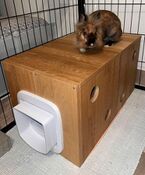
Further reading
- The Rabbit House, Monitoring Your Rabbit's Weight
- Nock's Rabbitry, Pamela Nock, Rabbit Weight Management
- MediRabbit, Esther van Praag Ph.D., Administration of drugs: the conformation of the rabbit body can be misleading...
- Colorado House Rabbit Society, One Fat and One Skinny in a Pair. (2012).
See also
References
- ↑ 1.0 1.1 1.2 1.3 Varga, M. (2013). Textbook of rabbit medicine. (2nd ed.).
- ↑ ARBA. (2014). Proper Posing and Evaluation. Retrieved 1 April 2016 from https://www.arba.net/PDFs/PosingSpring2014.pdf
- ↑ 3.0 3.1 3.2 Barbara L. Oglesbee, Blackwell's Five-Minute Veterinary Consult: Small Mammals, 2e.


